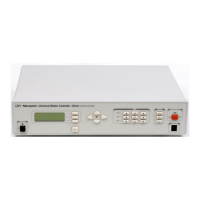Guidelines for further tuning (based on performance starting point and
desired outcome) are provided in the following paragraphs.
Following Error Too Large
This is the case of a soft PID loop caused by low values for Kp and
Kd. It is especially common after performing the procedures
described in paragraph 6.2.2.
First increase
Kp by a factor of 1.5 to 2. Repeat this operation while
monitoring the following error until it starts to exhibit excessive
ringing characteristics (more than 3 cycles after stop). To reduce
ringing, add some damping by increasing the
Kd parameter.
Increase it by a factor of 2 while monitoring the following error. As
Kd is increased, overshoot and ringing will decrease almost to zero.
Remember that if acceleration is set too high, overshoot cannot be
completely eliminated with Kd.
If Kd is further increased, at some point oscillation will reappear,
usually at a higher frequency. Avoid this by keeping
Kd at a high
enough value, but not so high as to re-introduce oscillation.
Increase
Kp successively by approximately 20% until signs of
excessive ringing appear again.
Alternately increase
Kd and Kp until Kd cannot eliminate overshoot
and ringing at stop. This indicates
Kp is larger than its optional value
and should be reduced. At this point, the PID loop is very tight.
NOTE
The tighter the loop, the greater the risk of instability and
oscillation when load conditions change.
NOTE
Ultimately, optimal values for
Kp and Kd depend on the stiffness of
the loop and how much ringing the application can tolerate.
Section 6 – Servo Tuning 6-3

